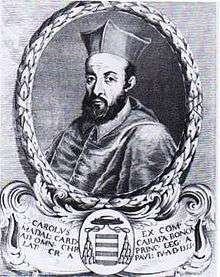Carlo Carafa

| Styles of Carlo Carafa | |
|---|---|
 | |
| Reference style | His Eminence |
| Spoken style | Your Eminence |
| Informal style | Cardinal |
| See | Naples |
Carlo Carafa (29 March[1] 1517 – 6 March 1561) of a distinguished family of Naples, vicious and talented[2] was successively condottiero in the service of France and of Spain, vying for their protectorates in Italy until 1555, when he was made a cardinal,[3] to 1559 the all-powerful favourite and Cardinal Nephew of Pope Paul IV Carafa, whose policies he directed and whom he served as papal legate in Paris, Venice and Brussels. According to the Jesuit and later Cardinal Pietro Sforza Pallavicino, writing the history of the Council of Trent, his subtlety of spirit and grace of address, physical courage and instinct for glory were overridden by his insatiable thirst for power.[4]
He was born at Naples into one of the city's most ancient and distinguished families, a younger son of Giovanni Alfonso Carafa, count of Montorio, and his countess, Caterina Cantelma. One brother was Giovanni Carafa, Duke of Paliano another, Antonio Carafa (1520—1588), was made marchese di Montebello.[5]
Without making a name for himself,[6] he had a long and dubious career as a mercenary soldier in Italy and Germany. He entered the household of Cardinal Pompeo Colonna at an early age, as a page and was enrolled in the Order of St John of Jerusalem later, that of Pierluigi Farnese, duke of Castro, the son of Paul III. He then fought under the Alfonso d'Avalos, marchese del Vasto, in Lombardy and Piedmont, and under Ottavio Farnese, Duke of Parma, in Flanders and Germany, fighting Protestants in the name of the Emperor. Here an incident occurred that illuminates his greed, arrogance and violent nature: his possession of captive gentleman worth a considerable ransom was challenged by a Spaniard, whose right was upheld by his compatriot, the duke of Alba; and in the aftermath Carlo, pursuing his adversary to provoke a duel was incarcerated at Trent until he agreed not to pursue the vendetta.[7] He was exiled from Naples in 1545 for murder and banditry and, having withdrawn to Benevento, was embroiled in another assassination.[8] was alleged to have perpetrated the massacre of Spanish soldiers as they recuperated in a hospital in Corsica.
Two weeks after Giovanni Pietro Carafa was elected pope, as Paul IV he raised Carlo to the cardinalate 7 June 1555. His tenure as Cardinal Nephew was not a great success as he and Paul IV brought the Papacy to a humiliating defeat against the Spanish that nearly resulted in another Sack of Rome. Carlo's government was unpopular in Rome and he developed a reputation for avarice, cruelty and licentiousness, as well as for sodomy. In January 1559, Paul IV finally accepted the accuracy of the accusations made and exiled both his nephews from Rome and replaced Carlo as Cardinal Nephew with Carlo's own nephew Alfonso Carafa, cardinal archbishop of Naples.
In June 1560, Paul's successor, Pope Pius IV arrested the leading members of the family, Carafa, his brother the duke and their nephew the cardinal archbishop of Naples,[9] seizing their papers, on a range of charges relating to abuses of power during Paul's reign. Carlo was charged with a range of crimes, including not only sodomy but also murder and promotion of Protestantism. After a nine-month trial, the cardinal was condemned along with his brother Giovanni and was executed by strangulation at Castel Sant' Angelo on the night of 6 March 1561. His execution was considered at the time to have been motivated primarily by political factors such as his pro-French, anti-Spanish policies.
On September 26, 1567, the sentence was declared unjust by Pope Pius V. The memory of the victims was vindicated and their estates restored.
Notes
- ↑ The date was unknown to Carafa's biographer Georges Duruy.
- ↑ "de grands vices unis à de grands talents" according to his biographer Georges Duruy, Le Cardinal Carlo Carafa (1519— 1561): étude sur le pontificat de Paul IV Paris, 1882:viii.
- ↑ Salvador Miranda, "Cardinals of the Holy Roman Church: Carlo Carafa": accessed 25 August 2010]
- ↑ Pietro Sforza Pallavicino, Istoria del concilio di Trento, Milan, 1745, vol. 13, ch. 12, quoted by Duruy 1882:10/
- ↑ Maria Gabriella Cruciani Troncanelli, «CARAFA, Antonio». In: Dizionario Biografico degli Italiani, Volume 19, Roma: Istituto dell'Enciclopedia Italiana, 1976
- ↑ The Venetian ambassador Navagero took pains to uncover some of the previous career of Carafa, once he had suddenly arrived at a position of power: see Duruy 1882:7ff.
- ↑ Duruy 1882:5.
- ↑ Duruty 1882:8.
- ↑ Their names have been torn from the cover of the trial manuscript, Archivio di Stato, Rome: Archivio criminale 54 (Duruy 1882:xv)
External links
|